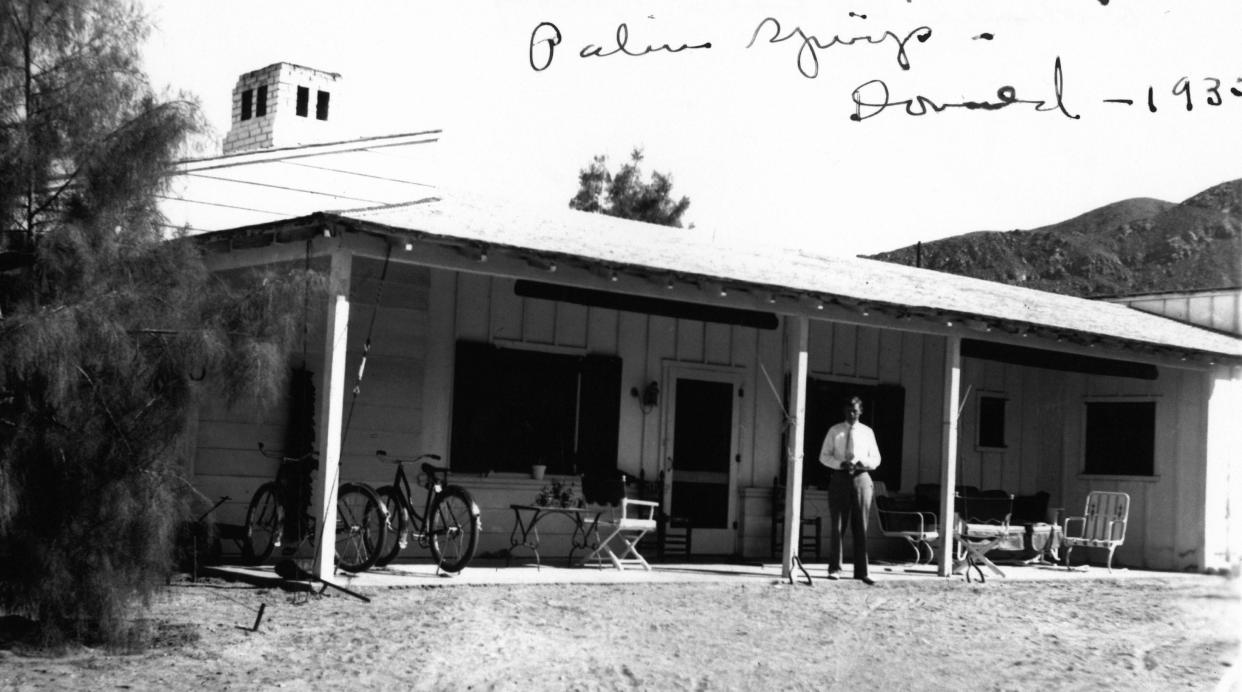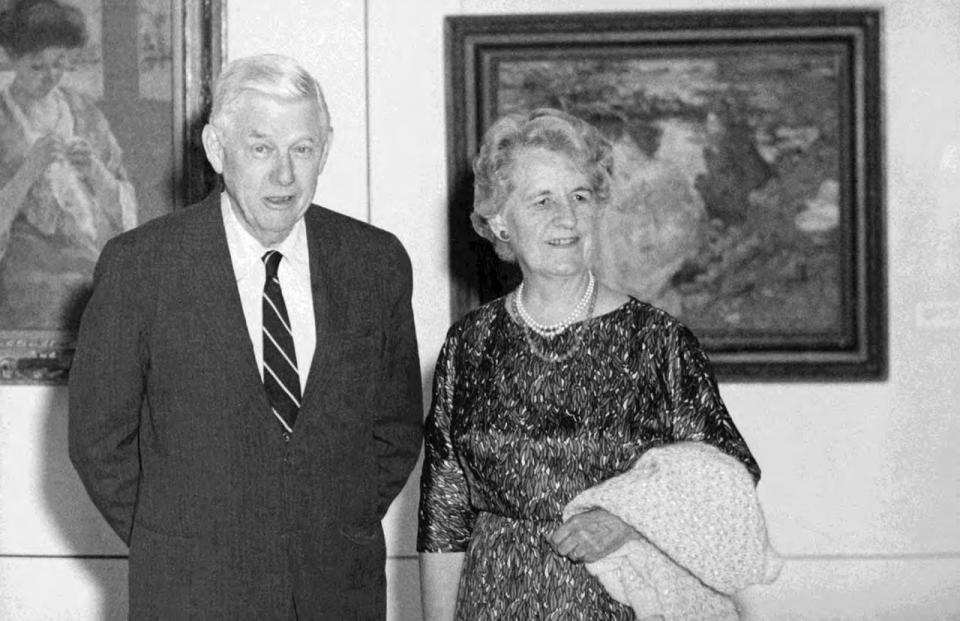Blankenhorn/Gilmore house in Palm Springs recommended for historic designation

- Oops!Something went wrong.Please try again later.
- Oops!Something went wrong.Please try again later.
- Oops!Something went wrong.Please try again later.
Painted on the window above the Victorian-style apothecary on Main Street at Disneyland was the name “D.S. Gilmore, M.D.” The name is still visible today, although the pharmacy below has since been overtaken by other retail offerings, but interestingly, Donald Gilmore was not a medical doctor.
The name was placed there in 1954 during construction of Disneyland, with a gentle wink by Walt Disney himself, in homage to his friend and neighbor in Palm Springs at Smoke Tree Ranch, who was then chairman of the board of The Upjohn Company.
The pharmaceutical manufacturing company was founded in 1886 in Michigan by William E. Upjohn, M.D. who, with his physician brothers, founded the company and invented the friable pill, designed to be easily digested. Prior to the innovation, medicines were nasty-tasting tonics or odiferous topical concoctions. That a solid pill could be easily swallowed and deliver medicine without any associated insult, made Upjohn a successful company.
According to an Upjohn history written in 1934, “The first pills made were not coated, but in order to compete with the popular sugar coated pills of the time, a method of coating the friable pill was devised. The result was highly pleasing, as it was found possible to adopt a wide range of attractive colors, and to apply a fine polish. The elegant appearance thus imparted to the product contributed much to its rapid growth and popularity among physicians."
Gilmore married Genevieve Upjohn, daughter of W.E. Upjohn, and was convinced by his father-in-law to join the board in 1929 and then the company in 1930. Historian Steve Vaught writing for the Palm Springs Preservation Foundation’s historic nomination noted, “Many businesses were going under as the devastation of the Great Depression took hold. While other companies cut back, Gilmore expanded, enlarging Upjohn branches from 3 to 11. He also devoted a great deal of resources into research and development, increasing the department from a small number to more than 1,000. Gilmore’s innovations paid off, and the company not only survived the Depression, it exploded in size and influence … the company had a great influence on medicine during World War II, ramping up production of penicillin and the creation of the sulfa sterile wound-dressing packet, which has been credited as saving literally millions of lives during the war.”
Under Gilmore’s stewardship it became a pharmaceutical behemoth.
By the time Disney asked Gilmore to open a storefront at his new project in Anaheim, they had both spent a good deal of time in Palm Springs, and the imaginative Gilmore had wisely invested in Disney’s amusement park.

The Gilmores came to the desert by train escaping the cold Michigan winters and in 1935 purchased a most handsome house to the south of the little village of Palm Springs on a nascent development called Smoke Tree Ranch. Built by Louis McLaughlin “Mac” Blankenhorn, the house was perfectly situated to the expansive desert surrounding it.
Constructed of board and batten and positioned to capture the gorgeous mountain views to be had in all directions, the house was designed by Garrett Van Pelt in a rambling ranch style that was distinctive and elegant. Two striking shed roofs abutted a gabled roof that covered two deep porches, one facing east and another west, which sandwiched the living room between. The facades are decidedly horizontal allowing for views to the mountains over the building and punctuated by steel casement windows in a pleasing regular rhythm.
Blankenhorn conceived of a development that respected the desert. Lots were exceedingly large, and the streets were offset and unexpectedly and occasionally curved or jogged. The entire effect was intended to emphasize the natural environment. Blankenhorn commissioned Van Pelt to design something special. Blankenhorn had built the house for himself, but the death of his wife caused him to sell and he found enthusiastic buyers in the Gilmores who appreciated the wide-open desert setting and Van Pelt’s charming design.
Van Pelt was a major figure in Southern California architecture for more than half a century. Architect Henry Eggers recalled, “The work of Mr. Van Pelt has been, for a great many years, outstanding … his work was largely in residential design and invariably exhibited those qualities which do not grow old. His houses are still some of the best in Southern California.”
Descended from the prominent New York Beekman and Van Pelt families, after much travel and work, he landed in Pasadena with Sylvanus Marston hired him as a draftsman and then quickly elevated him to partner in the firm. The Blankenhorn commission brought him to Palm Springs where he was enchanted enough to open up shop.
Van Pelt opened an office in association with George Lind, that would prove seminal for modern architecture. Van Pelt hired two young unlicensed architects to work for him who would become synonymous with architecture in the desert, Albert Frey and John Porter Clark.
According to Vaught’s excellent nomination, Frey later wrote, “I had the privilege to work for (Van Pelt) from 1935-1937 and came to admire his design ability and integrity, and his serious study of architectural forms. He has always recognized the importance of relating buildings to their surroundings, and thus his works have attained a timeless quality.”
Vaught concludes that the time Clark and Frey spent working for Van Pelt was a critical moment in both their careers “allowing them to explore architectural solutions to the challenges of desert living.”
It was also Van Pelt who provided entrée into Smoke Tree Ranch. Interestingly, Frey would subsequently become the “ranch architect” for the next 50 years, designing scores of modern houses in the ranch vernacular. Frey would add to the Blankenhorn/Gilmore house, originally designed by his mentor, several times in the ensuing decades.
The Gilmores had the house decorated by Barker Brothers and extensively photographed in 1940 after their updates. The Maynard Parker images, housed at The Huntington, are worth seeing as they document a more gracious time. The Gilmores and their extended family regularly visited Palm Springs during the winters, often traveling on the Super Chief.
Gilmore served on the Upjohn board for some 50 years, resigning only months before his death in 1979 at the age of 84. His descendants would continue to own the treasured house until very recently, when it was fortunately purchased by preservationist Eric Ellenbogen, who will be an excellent steward of this most important house.
Unanimously recommended by the City of Palm Springs’ Historic Site Preservation Board this week for Class I designation, the Blankenhorn/Gilmore house could not be more deserving, and the superb nomination written at the behest of the Palm Springs Preservation Foundation by historian Vaught is a pleasure to read and the Maynard Parker images are reproduced there.
This article originally appeared on Palm Springs Desert Sun: Palm Springs: Blankenhorn/Gilmore house recommended for historic designation

